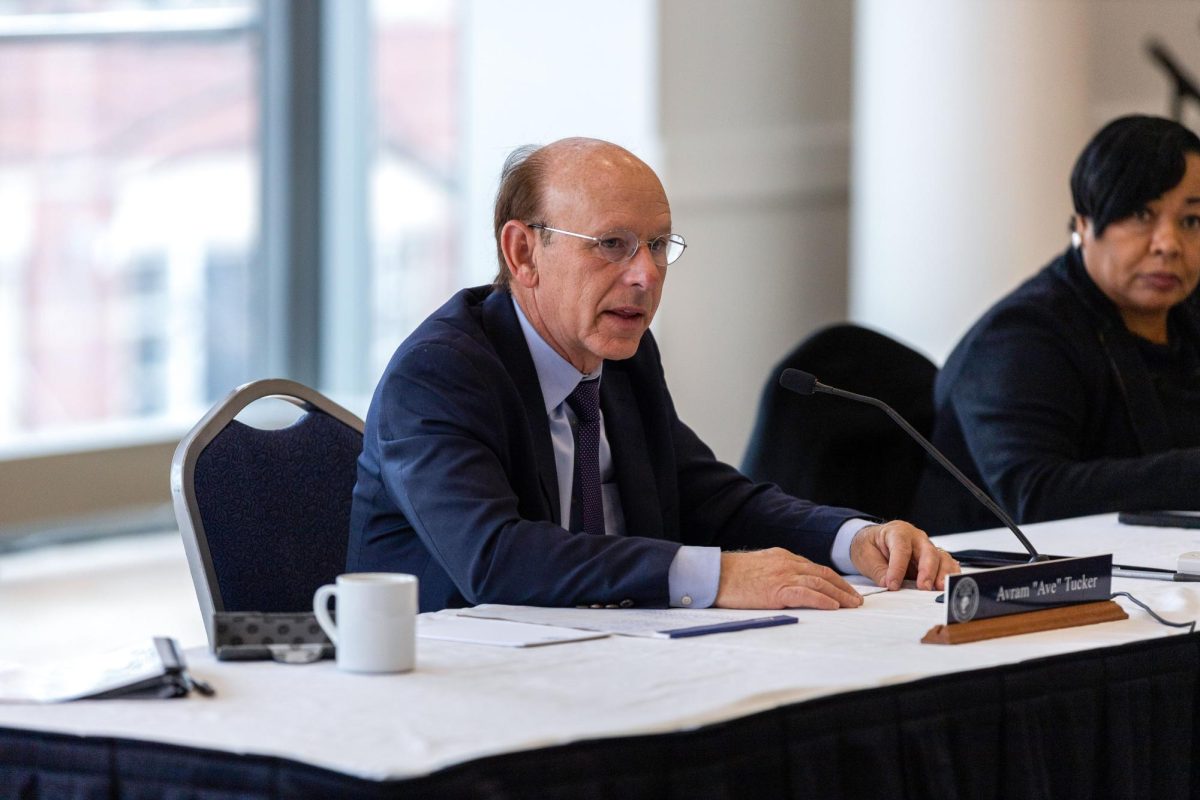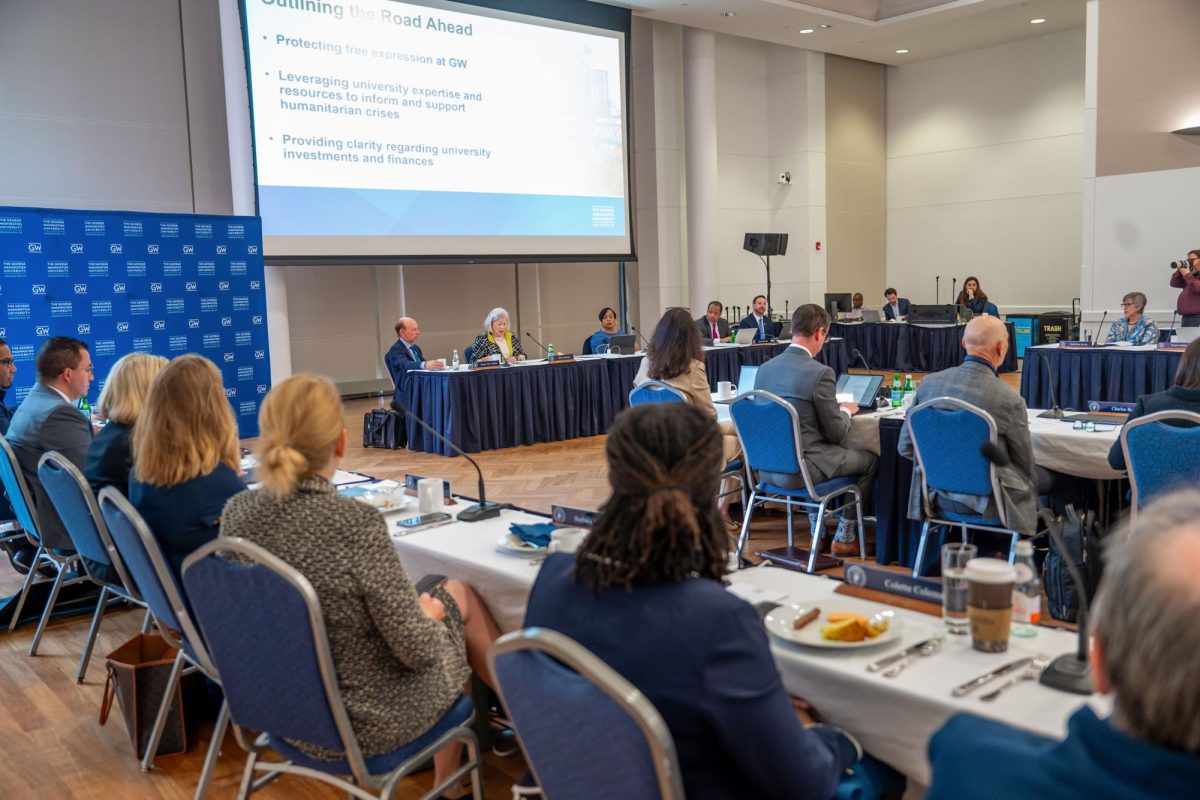GW’s endowment dropped $200 million between April and July, which Chief Financial Officer Bruno Fernandes attributed to a decrease in value of the D.C. real estate market.
Fernandes said the endowment drop is “entirely due” to a depreciation of the District’s real estate market and previous increases in interest rates by the Federal Reserve between March 2022 and July 2023. The Board of Trustees said last week that the University’s endowment — a pool of funds and investments gifted to the University, including allocated funds for scholarships and individual schools — decreased from $2.8 billion to $2.6 billion in quarter two, marking the first time the endowment has dropped since February 2023.
Trustees meet publicly three times a year to give updates from their respective committees and include the current endowment level in their reports.
“Inflation, market value and the ebb and flow of financial markets are all key factors that contribute to endowment fluctuations,” Fernandes said in an email. “The reduction in Q2 endowment value is entirely due to a downward valuation of the real estate market in the District of Columbia and previous increases in interest rates.”
Fernandes said GW’s endowment is invested in a “diverse portfolio” of funds that are regularly adjusted, with the goal of growing at a rate above inflation while providing a stable stream of income to support the funds’ purposes. He said officials regularly track and monitor the endowment to maintain it as an “enduring financial foundation.”
The endowment has not sat at $2.6 billion since February 2023. The drop comes after years of increase in the endowment’s value, which rose from $1.8 billion in fiscal year 2020 to $2.8 billion in February.
GW has faced small-scale fluctuations in endowments before, like a $20 million dollar decrease FY2019, which later rose by more than $20 million in FY2020.
GW also posted a job listing for a development and alumni relations donor fund compliance director in early August — which has since been removed — listing the main job duties as partnering with campus offices to address “unspent endowment payout” and finding solutions to encourage “consistent” spending.
Fernandes said officials created the donor fund compliance director position to maintain trust and accountability with donors.
Experts in higher education finance said fluctuations in universities’ endowment are usually based on interest and other outside factors, including market performance. Experts also said officials’ creation of the donor compliance position will allow the University to unlock funds to support GW’s academic mission and ensure that funds are spent in accordance to the donor’s requests.
Ali Sanati, an assistant professor of finance at American University, said endowments, which are typically nonprofit organization investments, differ depending how the University opts to invest their endowment. Sanati said professional fund managers and organization constraints are the primary actors in this allocation process.
GW releases a yearly Endowment Stewardship Report providing data on the endowment, including its value by school and purpose of the funds allocated to each school but does not disclose investment allocation details.
Sanati said it is difficult to “disentangle” which investments would have contributed the downturn due to a lack of “detailed data” and the diverse nature of GW’s endowments. He said over the last few years some universities have grown their endowments, while others have done “really badly” due to static performance in nonpublic markets.
“Endowments that had most of their allocations to publicly traded assets, publicly traded stocks, especially in the U.S., they’ve been performing really well over the past year,” Sanati said. “But endowments, who had a big chunk of their allocation to private markets, for example, or to alternative assets, such as real estate, such as arts, those types of endowments have not been doing very well.”
Sanati said GW does not necessarily need to change investment strategy based on short-term fluctuations in endowments due to markets’ “lack of predictability,” but officials should instead focus on “long-term performance.” He said it is the duty of endowment managers, the Board of Trustees and other monitoring figures to follow “diversification” and “long-term potential” principles when making strategic investment decisions.
“If these analyses are reasonably done and with due diligence, on average, over a long period of time, they turn out to yield a very good performance for the organization,” Sanati said.
David Yermack, professor of finance and business transformation at New York University, said successful investment portfolios rely on long-term holdings and diversification, meaning fund managers should stick to an investment strategy instead of focusing on stocks because they are prone to fluctuations. GW’s endowment is invested in five main categories including fixed income, global equity, hedge funds, private equity and real estate, with real estate representing almost half of the University’s fiscal year 2023 endowment.
“A very balanced portfolio of investments across the whole market is always the best rule,” Yermack said.
Experts in higher education and finance said earlier this year that revenue diversification can help compensate for the University’s financial weak points, and experts warned officials that creating a monopoly of one revenue stream could drain finances and attention away from universities’ academic priorities.
GW’s real estate endowment investment holdings were valued at $1.125 billion in 2023, a $491 million growth since 2014. The University purchased the Residences on the Avenue for $140 million in 2023 after selling the lease to the land 15 years prior. This property joins the additional 35 Foggy Bottom buildings GW acquired between 1985 and 2002 and previously owned real estate.
GW’s Office of University Controller oversees the endowment’s administration, while Strategic Investment Group, a third party company, manages a majority of the fund excluding real estate properties and “certain separately managed funds,” according to GW’s donation frequently asked questions. Strategic Investment Group manages asset allocation, portfolio construction, stewardship and access to strengthen clients’ investments.
Yermack said the University’s new donor fund compliance director role will address a collective problem universities face with unlocking unused investments specified for certain academic interests that have become obsolete as curricula and subjects change.
“You want the University 200 years from now not to be teaching the same things they’re teaching now in the 21st century,” Yermack said. “So the gifts that they have to support the mission have to also be adjusted to keep up with the times.”
Kwoloong Liaw, a finance professor at St. John’s University, said universities can “ride out” the temporary dips due to their long-term investment horizon and the established spending formula. He said the market values of endowments of universities across the country will continue to rise, and they have been on the uptrend for years and are expected to continue to increase.
Liaw said it is vital to ensure officials follow the agreements they makes with its donors, and the donor fund compliance director role position was likely created to ensure adherence to the University’s agreements with donors.
“In general, as the size of endowment increases, it is prudent to have a dedicated personnel to ensure compliance, as the number of donors increases, and their specific requirements expand,” Liaw said in an email.








